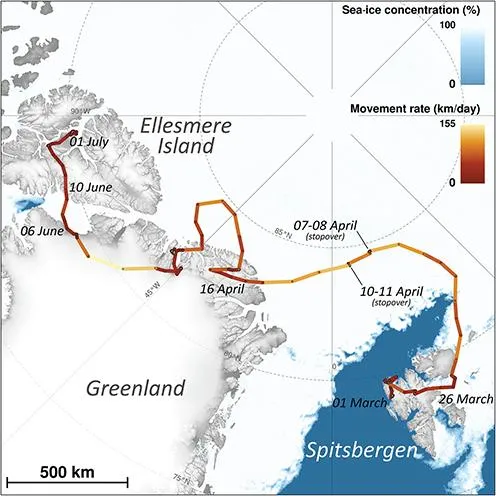A Young Arctic Fox Traveled From Norway to Canada in 76 Days
The animal trekked an average of 28 miles per day, covering a distance of 2,175 miles during her journey from Spitsbergen to Ellesmere Island
:focal(250x605:251x606)/https://tf-cmsv2-smithsonianmag-media.s3.amazonaws.com/filer/d4/17/d417d7de-eca9-402f-af05-e1b970f34b24/de5e97da69f2456c94c9d6b6d65c134d-jumbo.jpg)
On March 26, 2018, a young Arctic fox left her birthplace of Spitsbergen, an island in Norway’s Svalbard Archipelago, and embarked on a harrowing westward journey. Seventy-six days and more than 2,175 miles later, the roughly one-year-old female arrived on Canada’s Ellesmere Island, astonishing researchers who say the animal, traveling at a maximum pace of 96 miles per day, exhibited the fastest movement rate recorded for her species to date.
The fox’s expedition, followed by scientists via a tracking device fitted in July 2017, is newly catalogued in the journal Polar Research. As the study’s co-authors, Eva Fuglei of the Norwegian Polar Institute (NPI) and Arnaud Tarroux of the Norwegian Institute of Nature Research (NINA), write, the trip was impressive not only for its speed, but also for distance covered by such a small animal. (Per National Geographic, the Arctic fox, also known as a coastal or blue fox, weighs between 6.5 to 17 pounds and measures 31.75 to 40.5 inches from head to tail.)
“We couldn't believe our eyes at first,” Fuglei tells Norwegian public broadcaster NRK, as translated by BBC News. “We thought perhaps it was dead, or had been carried there on a boat, but there were no boats in the area. We were quite thunderstruck.”
According to the Associated Press, the female—likely searching for food or a new home in which to settle down and breed—began her trek on March 1, exploring different areas of Spitsbergen before departing the island on March 26. Over the next 21 days, she made her way to Greenland, covering a distance of some 940 miles.

From here, Alison Rourke reports for the Guardian, the fox continued toward her ultimate destination, reaching Canada on June 10 and finally settling down on Ellesmere Island, 1,242 miles beyond Greenland, on July 1. She traveled an average of 28 miles per day and reached a maximum pace of 96 miles per day while coasting along the ice sheets of northern Greenland. As Rourke notes, this speed suggests the juvenile was using the ice as a “means of transport” rather than as a foraging location.
In total, the fox traveled 2,743 miles over a period of four months, March 1, 2018, through July 1, 2018. Although an adult female fox covered a similar route totaling 2,800 miles in 2010, according to NPR’s Dani Matias, she completed the trek in 5.5 months rather than four. The younger fox also broke the species record for speed, outpacing a previously tracked adult male by 1.4 times.
In an NPI statement, Norway’s climate and environment minister, Ola Elvestuen, emphasized the importance of sea ice in enabling animal migration. “The warming in the north is [happening] frighteningly fast,” he adds, warning, “We must cut emissions quickly to prevent the sea ice from disappearing all summer.”
For now, it remains unclear what exactly happened to the determined female fox, as her transmitter stopped working in February of this year. If she is still living on Ellesmere Island, it is under very different circumstances than those found in her home country of Norway. As the study notes, the fox originated in a coastal ecosystem rich with marine food resources. The main prey on her newfound home, meanwhile, is a type of rodent known as a lemming.
Given her track record, there’s reason to hope the fox is still out wandering in the wilderness. Regardless, Fuglei concludes to NRK, “This fox went much further than most others we've tracked before—it just shows the exceptional capacity of this little creature.”
/https://tf-cmsv2-smithsonianmag-media.s3.amazonaws.com/accounts/headshot/mellon.png)
/https://tf-cmsv2-smithsonianmag-media.s3.amazonaws.com/accounts/headshot/mellon.png)